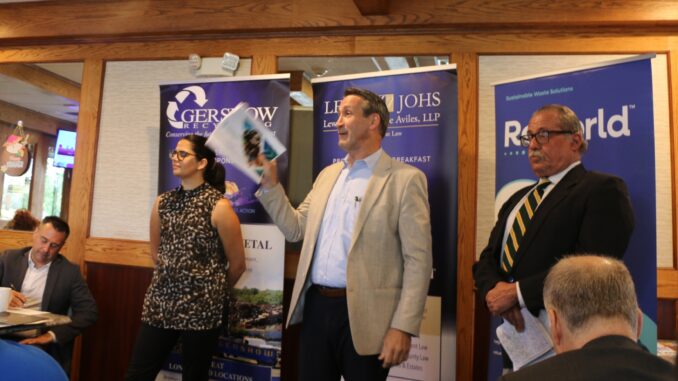
By Hank Russell
Members of LIMBA (Long Island Metro Business Action) had the opportunity to learn about the proposed Propel NY Energy project at their June 27 meeting at the Candlelight Diner in Commack. The guest speakers were Vice President, Project Management & Construction Peter Rooney and Communications & Public Affairs Manager Melanie Sinesi of Transco New York and Long Island Community & Government Relations Director Jim Certa of the New York Power Authority (NYPA).
Propel NY Energy is a 90-mile underground and submarine transmission project designed to strengthen New York’s electric grid. Transmission lines carry electricity long distances from where it’s generated to where it’s needed most—powering homes, businesses, and communities.
Sinesi said this project will include approximately 90 miles of new underground/ submarine transmission lines. The lines act as “highways,” in that they will be bidirectional, delivering electricity to and from Long Island. “They will stretch all the way from Westchester to Suffolk County,” she said, adding four new substations and upgrades to existing substations to maximize the use of existing utility-owned properties. “We don’t choose the energy source; we’re simply building out these lanes.”
Certa disabused certain notions about the project. “We are not a battery storage project,” he said. “We are not an offshore wind project. We are not wed to any one generation source and we are not permitted through the [state’s] RAPID [Renewable Action through Project Interconnection and Deployment] Act. We are a core infrastructure for all generation sources.”
The transmission lines are buried beneath the ground “so we can survive unfortunate weather events,” Certa said.
These improvements are needed, Certa said, because the infrastructure is very old and demand for electricity is expected to grow another 50-90% in 20 years. “To put it in context [when the transmission was built], Ronald Reagan hadn’t been elected president yet,” he said.
To install the lanes underground, Rooney said, they will use open trench and horizontal directional drill (HDD) techniques to minimize construction disturbances. Each trench will be approximately five to six feet wide, and each cable three to 5.5 inches in diameter.
HDD is a trenchless technology used since 1970 to install underground utilities. “We use that to go under [environmentally] sensitive areas,” Rooney said.
Propel NY Energy will be built using union labor, said Rooney, who has more than 30 years of construction experience. He said he was on hand for other energy projects being built by union members and was impressed.
“The one thing that impressed me was the quality of the work,” he said. “We had thousands of man-hours of work, no serious accidents and minimal downtime in the heat and cold.”
In addition, New York Transco and NYPA have been engaging in “an effective communications campaign” with members of the community before any work gets done. “We’ll let the people know what we are doing and how long we are going to be working,”
Sinesi said the Article VII application has been submitted, but noted the approval process is “very lengthy and prescribed,” taking years. Once approved, the team estimates “shovels in the ground” by mid-2026. The project is expected to be fully operational by 2030.
“We will have multiple crews on this,” Sinesi said. “This will be all hands on deck.”
The meeting was sponsored by PHOS Global Energy Solutions, a Stony Brook-based company. Victor Bica, the company’s project manager, co-founder and inventor, said the sponsorship was not “just about visibility, it was about showing up with a message.”
“We viewed this event as a unique opportunity to speak directly with people and companies that are actively shaping New York’s energy future,” Bica explained. “It was a chance to share what we’ve built and to listen, to better understand the practical needs and goals of those working at the intersection of renewable energy and public infrastructure. … Events like this provide companies like ours with a platform to not only present new ideas but also initiate conversations that lead to genuine partnerships, support, and impact.”
Bica said he was “especially encouraged” by the Propel NY Energy project. “Their mission to enable a cleaner, more resilient power grid through transmission innovation aligns closely with our values at Phos Global,” he said. “It was also reassuring to hear about their commitment to working directly with communities and businesses, as their openness to dialogue and sensitivity to community impact closely align with our values at Phos Global.
“The world is facing a genuine energy crisis, and the solutions must come from the people and companies directly engaged in addressing the day-to-day challenges,” Bica continued. “We hope to be part of that effort through collaboration, strategic partnerships, and clean, reliable technology that’s built to last.”

